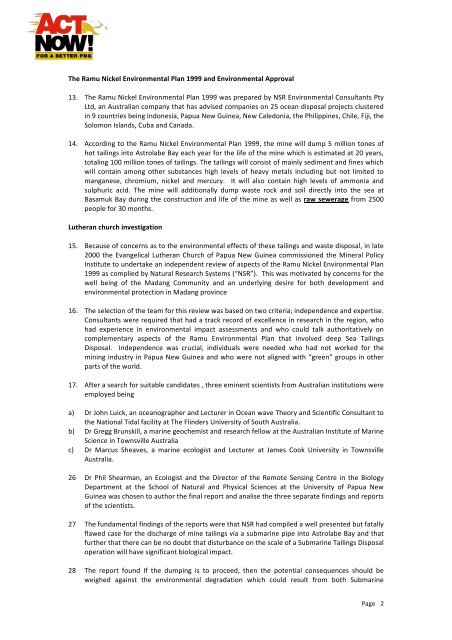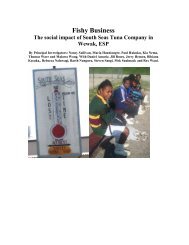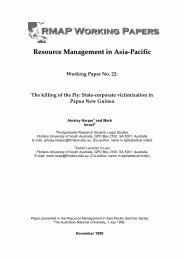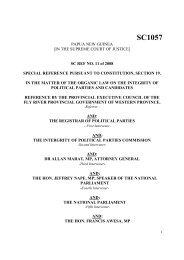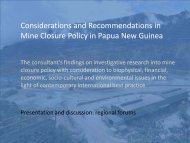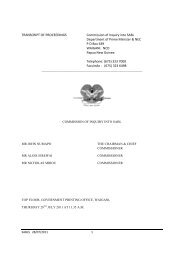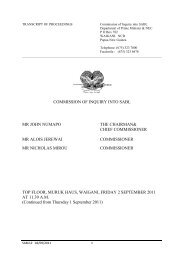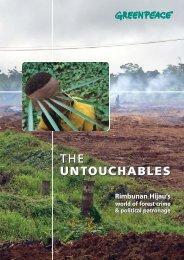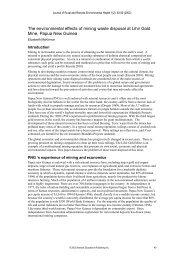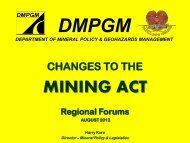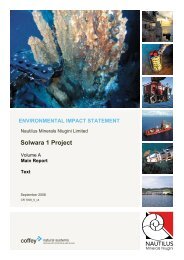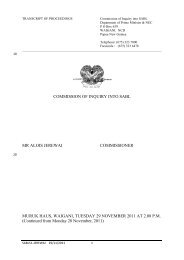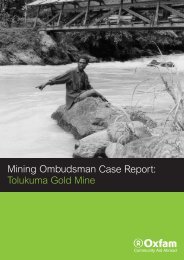A brief history of the Ramu nickel mine and the ... - Act Now!
A brief history of the Ramu nickel mine and the ... - Act Now!
A brief history of the Ramu nickel mine and the ... - Act Now!
You also want an ePaper? Increase the reach of your titles
YUMPU automatically turns print PDFs into web optimized ePapers that Google loves.
<br />
<br />
The <strong>Ramu</strong> Nickel Environmental Plan 1999 <strong>and</strong> Environmental Approval <br />
<br />
13. The <strong>Ramu</strong> Nickel Environmental Plan 1999 was prepared by NSR Environmental Consultants Pty <br />
Ltd, an Australian company that has advised companies on 25 ocean disposal projects clustered <br />
in 9 countries being Indonesia, Papua New Guinea, New Caledonia, <strong>the</strong> Philippines, Chile, Fiji, <strong>the</strong> <br />
Solomon Isl<strong>and</strong>s, Cuba <strong>and</strong> Canada. <br />
<br />
14. According to <strong>the</strong> <strong>Ramu</strong> Nickel Environmental Plan 1999, <strong>the</strong> <strong>mine</strong> will dump 5 million tones <strong>of</strong> <br />
hot tailings into Astrolabe Bay each year for <strong>the</strong> life <strong>of</strong> <strong>the</strong> <strong>mine</strong> which is estimated at 20 years, <br />
totaling 100 million tones <strong>of</strong> tailings. The tailings will consist <strong>of</strong> mainly sediment <strong>and</strong> fines which <br />
will contain among o<strong>the</strong>r substances high levels <strong>of</strong> heavy metals including but not limited to <br />
manganese, chromium, <strong>nickel</strong> <strong>and</strong> mercury. It will also contain high levels <strong>of</strong> ammonia <strong>and</strong> <br />
sulphuric acid. The <strong>mine</strong> will additionally dump waste rock <strong>and</strong> soil directly into <strong>the</strong> sea at <br />
Basamuk Bay during <strong>the</strong> construction <strong>and</strong> life <strong>of</strong> <strong>the</strong> <strong>mine</strong> as well as raw sewerage from 2500 <br />
people for 30 months. <br />
<br />
Lu<strong>the</strong>ran church investigation <br />
<br />
15. Because <strong>of</strong> concerns as to <strong>the</strong> environmental effects <strong>of</strong> <strong>the</strong>se tailings <strong>and</strong> waste disposal, in late <br />
2000 <strong>the</strong> Evangelical Lu<strong>the</strong>ran Church <strong>of</strong> Papua New Guinea commissioned <strong>the</strong> Mineral Policy <br />
Institute to undertake an independent review <strong>of</strong> aspects <strong>of</strong> <strong>the</strong> <strong>Ramu</strong> Nickel Environmental Plan <br />
1999 as complied by Natural Research Systems (“NSR”). This was motivated by concerns for <strong>the</strong> <br />
well being <strong>of</strong> <strong>the</strong> Madang Community <strong>and</strong> an underlying desire for both development <strong>and</strong> <br />
environmental protection in Madang province <br />
<br />
16. The selection <strong>of</strong> <strong>the</strong> team for this review was based on two criteria; independence <strong>and</strong> expertise. <br />
Consultants were required that had a track record <strong>of</strong> excellence in research in <strong>the</strong> region, who <br />
had experience in environmental impact assessments <strong>and</strong> who could talk authoritatively on <br />
complementary aspects <strong>of</strong> <strong>the</strong> <strong>Ramu</strong> Environmental Plan that involved deep Sea Tailings <br />
Disposal. Independence was crucial, individuals were needed who had not worked for <strong>the</strong> <br />
mining industry in Papua New Guinea <strong>and</strong> who were not aligned with “green” groups in o<strong>the</strong>r <br />
parts <strong>of</strong> <strong>the</strong> world. <br />
<br />
17. After a search for suitable c<strong>and</strong>idates , three e<strong>mine</strong>nt scientists from Australian institutions were <br />
employed being <br />
<br />
a) Dr John Luick, an oceanographer <strong>and</strong> Lecturer in Ocean wave Theory <strong>and</strong> Scientific Consultant to <br />
<strong>the</strong> National Tidal facility at The Flinders University <strong>of</strong> South Australia. <br />
b) Dr Gregg Brunskill, a marine geochemist <strong>and</strong> research fellow at <strong>the</strong> Australian Institute <strong>of</strong> Marine <br />
Science in Townsville Australia <br />
c) Dr Marcus Sheaves, a marine ecologist <strong>and</strong> Lecturer at James Cook University in Townsville <br />
Australia. <br />
<br />
26 Dr Phil Shearman, an Ecologist <strong>and</strong> <strong>the</strong> Director <strong>of</strong> <strong>the</strong> Remote Sensing Centre in <strong>the</strong> Biology <br />
Department at <strong>the</strong> School <strong>of</strong> Natural <strong>and</strong> Physical Sciences at <strong>the</strong> University <strong>of</strong> Papua New <br />
Guinea was chosen to author <strong>the</strong> final report <strong>and</strong> analise <strong>the</strong> three separate findings <strong>and</strong> reports <br />
<strong>of</strong> <strong>the</strong> scientists. <br />
<br />
27 The fundamental findings <strong>of</strong> <strong>the</strong> reports were that NSR had compiled a well presented but fatally <br />
flawed case for <strong>the</strong> discharge <strong>of</strong> <strong>mine</strong> tailings via a submarine pipe into Astrolabe Bay <strong>and</strong> that <br />
fur<strong>the</strong>r that <strong>the</strong>re can be no doubt that disturbance on <strong>the</strong> scale <strong>of</strong> a Submarine Tailings Disposal <br />
operation will have significant biological impact. <br />
<br />
28 The report found If <strong>the</strong> dumping is to proceed, <strong>the</strong>n <strong>the</strong> potential consequences should be <br />
weighed against <strong>the</strong> environmental degradation which could result from both Submarine <br />
Page 2


